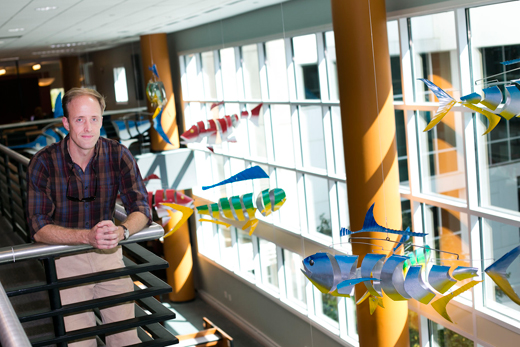The MacMillan Law Library has a new splash of color. Swordfish, jack fish, dolphinfish and red snapper flash as the aluminum mobiles catch the sunlight as they sway above the reading room in the lofty third floor atrium.
The library's newest art installation is the creation of Jonathan Milton, a graphic designer at Emory and the artist-owner of Big Mouth Mobiles.
Milton's handiwork adorns campus in more subtle ways, too. As a graphic designer in the Office of Planning, Design and Construction in Campus Services, Milton has created hundreds of signs, maps, event graphics and donor recognition displays.
The MacMillan Law Library is known for its art collection, with works by local artists mounted throughout the building. About two years ago, a law school administrator who knew Milton's artwork asked if he would be interested in donating a piece for the school. Working closely with the director of library services, Milton proposed a 10-piece saltwater fish mobile series. He spent several months creating the mobiles in his home studio. Milton installed the artwork in September, and "The Chase" is now on permanent display.
Emory Report talked with Milton about his art and design at Emory:
What do you hope will be the impact of your installation in the MacMillan Law Library?
My hope is that it inspires people to think beyond the two-dimensional world, to break away from the norm. The constantly moving mobiles are kinetic just like people; they slow but never stop moving, unlike two-dimensional pieces that people are usually familiar with.
Like the saltwater theme of "The Chase," many of your mobiles are fashioned into the shape of a fish or a leaf pattern. How does nature influence your art?
Nature is the ultimate designer-artist. I take influences from the fluid movements of fish and leaves. I try not to imitate the look of a certain fish or leaf; rather I put my own twist on the shape or color.
How did you discover a passion for art?
My passion for making art started with my middle school art teacher in Athens, Ga., Ms. Pitts, and grew from that point. I started making mobiles in college –- where I studied metalsmithing at Georgia Southern University -- and took a great deal of inspiration from the mid-century artist Alexander Calder. He pioneered the field of kinetic sculpture, thus creating what we know as the mobile. A great local example of his work is on the lawn of the High Museum of Art.
Is there a common thread between graphic design and art?
For me there is a common thread between what I do professionally as graphic designer and my artwork. The constant for me is the creation of a concept from an idea to a finished piece.
Your team was involved in creating new signage and graphics at Cox Hall and in the Dobbs University Center (DUC) dining hall. How would you describe the project and end result?
Barry Atwood and myself had the wonderful opportunity to work with Dave Furhman, the new Emory Dining director, to revision the environmental graphics and vendor branding for the dining halls. We were given the task of creating a cohesive look and feel to the DUC and to refresh its overall appeal to students. At Cox Hall we brightened the space with new graphics and colors while creating new food vendor branding. The end results really showcase our passion and range of design innovation and creativity.
In your seven years as a graphic designer with Campus Services, what project at Emory are you most proud of?
Honestly, every project I’ve done. Each project has its own challenges and rewards. No two are ever the same.
Suggest an Emory Profile
Do you have an Emory Profile suggestion? Send it to emory.report@emory.edu. Emory Report is always seeking faculty and staff with interesting personal or professional stories to spotlight in this regular feature series.

